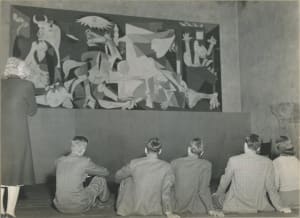Picasso: War, Combat, and Revolution
Saturday, Jan 20, 2024 10:00a -
Sunday, May 05, 2024 5:00p
Where:
Harvard Art Museums
32 Quincy Street
Cambridge, MA 02138
Admission:
FREE
Categories:
Accessible Spots, Art, History, University
Event website:
https://bit.ly/4atNph6
Pablo Picasso’s painting Guernica was commissioned by the Spanish government for the 1937 Paris World’s Fair. It was exhibited in Josep Lluís Sert’s Spanish Pavilion, alongside Joan Miró’s The Reaper and other works. Completed in early summer 1937, the massive 11 × 25 foot painting addresses the devastating Fascist-era aerial bombing of the Basque town of Guernica on April 26, 1937. More broadly, the painting confronts the horrors of war.
The current installation, which complements the Harvard course World Fairs, focuses on Picasso’s engagement with war, combat, and revolution. It explores Guernica’s core themes, the repressive Spanish dictator Francisco Franco, broader imagery of death, struggles of good and evil (represented by matadors, Minotaurs, Classical competition mythology), political and artistic revolution, and issues of desire and capture. Among those who faced Franco regime reprisals was Picasso’s friend Josep Rocarol. Book illustrations with African and other subjects (visual “primitivism”) had a seminal influence on Picasso in his early Paris years. These works include The Barbarian Dance and Salomé from 1905 and his transformative October 1906 figural studies. Studies based on this book imagery were foundational to his revolutionary March 1907 masterpiece Les Demoiselles d’Avignon, subsequent Cubist interventions, and Guernica itself.
This installation’s related course, World Fairs (History of Art and Architecture 194W and African and African American Studies 194Z), is taught by Suzanne P. Blier, Allen Whitehill Clowes Professor of Fine Arts and Professor of African and African American Studies, Harvard University.
-

Sponsored¡Conversaciones Crepusculares!: free in-person Spanish convo practice
Friday, May 02, 2025 4:00p
Boston Area Spanish Exchange (BASE)
-

Sponsored -

Sponsored


